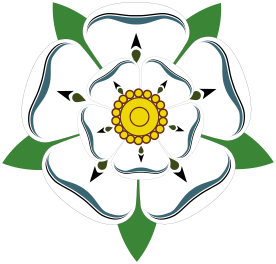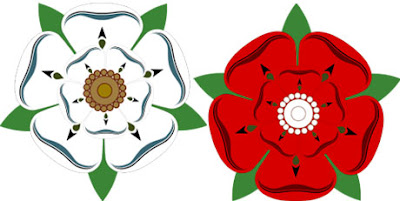Wars Of Roses, I'm Not Talking About Your Innocent Garden Flowers Here
Wednesday, May 18, 2011
Tuesday, May 17, 2011
Wars Of The Roses, Who was fight an why on earth would all that death be worth THAT?
 |
| Turdor Rose |
The war was a result of the recovery of the madness of the King Henry VI in the early 1455’s. King Henry VI was King Henry V’s infant son who was put on the throne, and sometimes suffered from fits of insanity, because of this the land owners found the King was not very stable and they could often do what they wanted to.While Henry VI was insane the nation was ruled by a council of nobles under the protection of Henry’s Kinsman, Richard, Duke of York. Some say that they believe that Richard was the rightful heir to the throne, not Henry. When Henry VI recovered from his insanity, the ‘old court party’ took over the monarch and government once again.
Who where the heads of each house, what allies did each have at the beginning of the wars?
The head of the red rose or the Lancastrian was a queen who was ‘a great and strong-labored French woman’; she looked to York as a threat to the succession of her last born son Henry. Her main ally was Edmond Beaufort, duke of Somerset who had recently been released from prison where his old enemy York, had sent him. Margret was the queen’s name, and she also had support of two northern noblemen, Lord Clifford, and Henry Percy, earl of Northumberland. Both of their hatred was directed towards York’s strongest allies, who had been fighting with them for years.
 |
| Yorks |
The head of the Yorks was the duke of York; York’s strongest allies were the earls of Salisbury and Warwick. They were both members of the Neville family who had been at war with the Percy’s for years. Even after York dies the name York will still be carried, York carries the white rose.
What was the first battle between the York’s, and the Lancastrians, and who was the winner?
The starting point for the wars of the roses was on May 22, 1445 at the town of St. Albans in the southeastern county of Hertfordshire. When King Henry recovered to his health, the duke of York and the Neville’s left London, to go home to their estates in the North. King Henry and his advisers summoned the three peers to a great council to be held at Leicester, on May 21; the disaffected lords believed the council would force them into submission, so they gathered hoping to intercept King Henry on his way to the council.
King Henry heard about York's march, and sent him a letter telling him to disarm or he would be called a traitor. It was May 21st by the time York's reply reached him, the reply stated that only the arrest of Somerset would make him happy. The King arrived at St.Albans, and kept house in the town square, while York and the Neville's stayed on a ridge east of town. King Henry and York negotiated for hours but could not agree on anything. York began to storm the gates of St. Albans, but fighting in such close quarters, the Yorkists couldn't use their advantage of numbers. King Henry's men stood their ground until Warick took a small force throught the gardens into the streets of the town, cutting the King's army in two.
Warick's attack gained him a reputation and many of the King's army began to flee; this allowed York to storm and overwhelm the men guarding the KIng. In minutes the Yorkists killed Somerset, Northumberland, and Lord Thomas Clifford. Under York's "protection" Henery was removed to the safety of the abby, and he made peace with the victors. The First Battle Of St. Albans made the sons of the slane peers into enemies of York, and they would be sure to make his time of power be short and troubled.
 |
| White Rose Victory |
What happend at the Battle of Wakefield?
The Battle of Wakefield happened on December 30th, 1460, this battle killed the duke of York. and revived the money of the Lancasterians. The money that the Lancasterians had become low with the defeat and capture of King Henry VI. It also caused York's ally Richard Neville, Earl of Salisbury, and his second son, Edmund Plantagenet, Earl of Rutland's death. Two months after the battle of Northampton, York came back from Ireland where he was exiled to. In October York stated his claim to the throne to the English Parliment.
The lords forced the duke to accept the Act of Accord, which means that King Henry still has the throne, but it showed the succesion of York and his heirs. In Wales, Queen Margret Of the Lancasterians did not want to accept the disinheirtence of her son Prince of Wales. In the North Henry Beaufort, third duke of Somerset, joinded forces with Henry Percy, third earl of Northumberland, Lord John Clifford, to make a sizable Lancasterian army. Responding to the threat York and Salisbury left London December 9th with an army of about 6,000. They wanted to bring the Lancasterians to war.
 |
 |
| Lancasterian Victory |
Subscribe to:
Comments (Atom)


